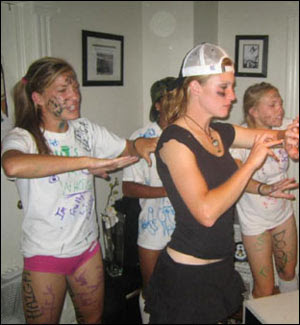Have you ever looked back at old photo albums, seen what you were wearing and almost cried? For me, eighth grade was the peak of all my fashion catastrophes. This was when I was certain oversized t-shirts, shoulder pads, and excessive bronzer was the way to go.
In Hollywood, fashion slip-up’s don’t hide in old yearbooks, instead, they are plastered across magazines, “worst dressed” lists, and “fashion don’t” tips for all to take note of. We’ve all seen our fair share of Brittany Spears, Amy Weinhouse, and Lil’ Kim trying to put their own spin on fashion and having it bite them in the you know what time and time again. Or the “repeat offenders” like Jessica Simpson and Lindsay Lohan who get ridiculed for wearing their $3,500 Gucci bag more than once, when most of us can barely afford the zipper on it?


Most celebrities hire stylists, make-up artists and hairdressers to make sure they look perfect 24/7. And although we hate to admit it, we associate many styles with different celebrities. We all know Paris Hilton is infamous for her color coordination, even having two cars that match the majority of her outfits; a pink and a powdered-blue Bently. Justin Timberlake’s casual-cool style is identifiable throughout the country. While Patrick Stump of Fall Out Boy looks funny without his messenger hat, no one can forget Madonna’s cone-shaped bra. Fashion is more than what type of material you wear, it gives celebrities a stamp. Fashion is supposed to reflect your personality and originality but many people loose their distinct style as they empty their bank accounts and try to duplicate the unaffordable styles of many celebrities. Jessica Simpson toting a Bulga bag. Lindsay Lohan wearing a Dolce & Gabbana gown. Katie Holmes buying Koi Placebo jeans. In nearly every fashion and entertainment magazine on the stands, at least one page is dedicated to what celebrities are wearing. So how does this impact the way we, the non-star-studded general public, dress?
To understand why we obsess over which pair of sunglasses Ashley Olsen is wearing or which handbag Sarah Jessica Parker is carrying, we must first ask the question:
Why are people so obsessed with celebrities in the first place?
“Stars seem to fulfill a fantasy that almost all of us share; that we can throw off the past, transcend the realities of our lives and be reborn as singular selves whose importance can't be denied," explains Michael Joseph Gross, author of the book Starstruck: When a Fan Gets Close to Fame.
If stars fill our personal aspirations of fame and fortune, then it seems only natural that wearing garments similar to theirs will put us one step closer to living out that dream. To many, “Stars are models of what is to be acceptable, or acceptably rebellious or even acceptably geeky. In high school, you're desperate for shortcuts to acceptance, so you go for that preppy outfit from Sixteen Candles or Eminem's baggy jeans or whatever, because it gives you some security and street cred." (Gross, M)
Throwing on celebrity’s fashion ideas may give fans a healthy dose of self-esteem, but did you ever stop to wonder how celebrities feel about their fans, and what they think about their admirers dressing like them? Many times celebrities are curious about their fans. This is because many times celebrities identify with their fans because many of them are fans themselves. Even the biggest names in the celebrity world are attempting to dress like the stars they most admire, for example Christina Aguilera channeling Marilyn Monroe, Britney Spears mimicking Madonna and Simpson imitating Bridget Bardot. Imitation may be the highest form of flattery, and no one understands that mentality better than corporate America. Once companies realized the affect celebrity branding had on the masses, celebrities began popping up in ad campaigns for items ranging from high-end designer goods to aspirin and cigarettes. These companies convince you that you identify with that celebrity. “Glo” by Jlo will make you smell just like her, or a certain jewelry will make you glitter and stand out like Paris Hilton. Consumers feel closer to their favorite celebrity by buying the products they advertise with.

With the Internet, it's becoming increasingly easy to buy what your favorite celeb is endorsing. Through Web sites like Jessicastyle.com , fans can log on, find out what their favorite blond singer and actress has recently been spotted in, and then purchase that item right then and there. Fans can also track Lohan at Lindsaystyle.com , Nicole Richie at Nicolestyle.allstarz.org and the cast of the television series The O.C. at Ocstyle.allstarz.org. These Web sites offer a new frontier in bringing fans one step closer to their favorite stars. Many of these sites have helped redefine the way celebrities dress, which is a plus for their fans. Celebrities understand are the trendsetters of our time, so instead of wearing Dolce and Gabana and couture all the time, they are wearing clothing and accessories that are more accessible to the general public. Celeberties are now shopping at places like Girlshop.com or Shopkitson.com, which makes it easier to imitate their style.

So while many of us are goggling the most trendy purse of the season, the other half of us are reading and hearing about the new gossip about their favorite celebrity. Especially in this dire economy, distraction plays a key role in helping us to avoid some of the inevitable stress that permeates our everyday lives. Why focus on your problems, when you can spend hours chatting about the tragedy of young lovers Chris Brown & Rihanna? And who needs to sulk behind your lack of shopping funds when you can surf the web to find pictures of Mary J. Blige on a perpetual shopping spree in the most expensive shopping districts of NYC? But in reality, celebrities are flesh and blood, just like us, but these days, the entertainment they provide includes virtually every aspect of their lives.
--J.T.















